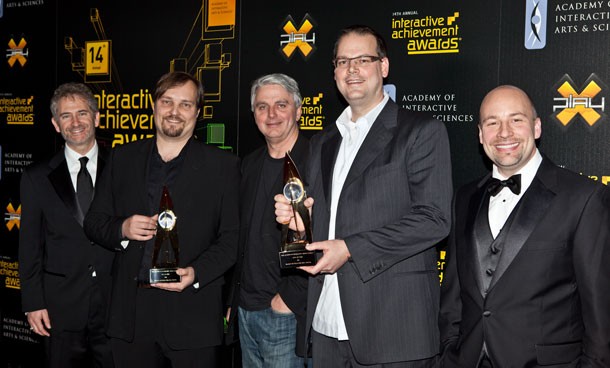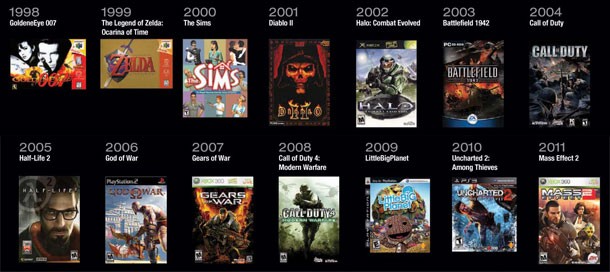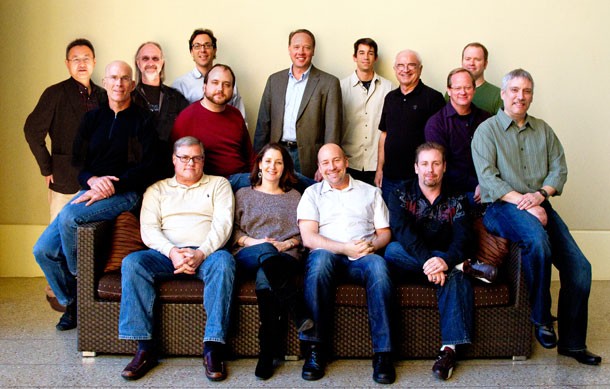Please support Game Informer. Print magazine subscriptions are less than $2 per issue
The Interactive Achievements Awards – The Oscars Of Video Games

For the general public, the Spike Video Game Awards are the most prominent industry award show. This annual spectacle has the brightest lights, the loudest music, the biggest stars, and airtime on a major cable television network. But sometimes amongst the pomp and pageantry of celebrity skits, preview trailers for upcoming titles, and musical performances, the show creators seem to forget why the VGA's exists in the first place – to celebrate the best games of the year. This past year, many of the award presentations and acceptance speeches weren’t even televised.
This irked some of the show goers who believed they were invited to the show to be involved in the proceedings. Actor Mark Hamill, who received a nod for his excellent voice work as the Joker in Batman: Arkham City, felt slighted by the way the awards were shoved to the side.
“Weird VGAs!,” he tweeted. “Don’t mind losing but I’d like to know when it happens. Did I miss something? Award given off-camera? Tara & I in lousy seats BOO!”
His Batman co-star Tara Strong, who voiced Harley Quinn, also shared her dismay, tweeting “Hey, @SPIKE_TV, if you weren’t going to announce the nominees, why have us come to the show? VO may not matter to you, but it sure does to us. I mean, I got my make-up done; I at least wanted a close up of my face when I lost but pretended to be happy for someone else!”
Thankfully, alternatives exist for those interested in seeing serious recognition for video game accomplishments. Fifteen years ago, the Entertainment Software Association (ESA) sanctioned the Academy of Interactive Arts and Sciences (AIAS) to help recognize artistic achievement in the world of video games with the Interactive Achievement Awards (IAAs), which are celebrated quietly every year at the Design, Innovate, Communicate, Entertain (DICE) summit. Starting in 2009, cable channel IFC started broadcasting half-hour recaps of the awards show, and expanded the coverage into live streams of the full event. This year, the coverage is shifting to gamespot.com, which is airing a live stream of the show on February 9 hosted by comedian Jay Mohr.

From left to right: Mike Morhaime (Blizzard), Dr. Greg Zeschuk (former-BioWare), John Riccitiello (EA), Dr. Ray Muzyka (former-BioWare), Mike Capps (Epic Games president) after the doctors received Hall of Fame accolades.
Striving for Legitimacy
If the Spike VGAs are equivalent to the MTV Music Awards, then consider the IAAs the Oscars. Just like the film industry’s Academy Awards, the IAA voting panel is composed entirely of peers who work in the gaming industry. This is a major distinguishing factor that separates the IAAs from the Spike VGAs, which are decided upon by a select group of journalists and public voters. AIAS president Martin Rae considers the Oscars comparison reasonable, saying, “I think it’s fair to say that absolutely our goal is to be the preeminent vehicle for individuals in our industry and for titles in our industry.”
According to Rae, the similarities between the IAAs and the Oscars expand beyond the peer review process. “It’s not a popularity contest or a consumer-driven contest,” Rae says the award recipients are not necessarily the best-selling or most financially successful games of the year, but rather the ones that the industry feels were the most innovative and moved the medium closer to being widely considered a form of artistic entertainment.
“I think it’s very important from a historical and contemporary perspective to recognize talent and great achievement in an artistic industry, and it becomes historically relevant as your industry grows and matures,” Rae says. “We’re a pretty young industry from that perspective, but if you look back and you look at the history of the motion picture academy and who they recognize and why they’ve recognized them, and the historical archive they’ve built, it’s just important for the industry.”
Insomniac Games CEO Ted Price, who serves on the academy’s board of directors, believes the awards are critical to showing the rest of the world how far the interactive entertainment industry has come.
“Our goal is to demonstrate clearly why games hold their own against and surpass, in many cases, other forms of entertainment when it comes to an art form,” he says. “The academy exists to recognize the amazing creativity that goes into games of all types and to help promote them to not only the industry, but to the rest of the world.”

Past IAA Game of the Year Winners. Thatgamecompany's Journey took home the award for 2012.
The Peer Process
For board members like Price, this is a labor of love. The AIAS is a non-profit organization whose output is based purely on the volunteer efforts of its members. Members of the industry become involved because they want video games to be legitimized as an art form.
“Ours is a very peer-driven process, and it relates much more to and goes back to the people who make games, and when you have peers awarding peers in a process I don’t think you can have a better award,” Rae says.
Board member Denny Thorley agrees. “There is certainly a place for the other awards and they do a good job and it’s great, and they help us all in the industry, but there is something to be said by being recognized by your peers in the industry,” he said.
For a game to be eligible for an IAA, first a publisher must submit its games for consideration. For each award category, a group of volunteer peers is assembled to discuss the possible candidates. If it’s a craft discipline award, like gameplay engineering, then the peers must have some level of expertise in that field. If it’s a genre award, then the peers of that group must have expertise in that genre. For example, all the members of the peer group selected to decide nominees for the action game category have either worked on, or are currently working on, action games.
A publisher or developer must be a member of the AIAS in order to submit a game. However, there is a write-in system that allows for games that were not initially submitted to be considered. In 2010, Take-Two Interactive was not a member of the academy, a little game it published called Red Dead Redemption ended up taking home five awards through the write-in process – more than any other game that year.
Once the list of games is finalized, the peer groups must play all of the games. Afterwards, they meet to discuss which games should be eligible for voting. When all the candidates have been decided, AIAS members vote through a secure online ballot. All the games considered for any award are also eligible to receive the Game of the Year award.
AIAS has also made tangible contributions to the industry by creating two different scholarships. The Randy Pausch Scholarship fund was created in honor of Dr. Pausch, who was a co-founder of the Entertainment Technology Center at Carnegie Mellon University. This scholarship is awarded to students interested in pursuing a degree in the development of interactive entertainment. AIAS also helped found the Mark Beaumont scholarship fund, which is awarded to students specializing in the business side of interactive entertainment. The Beamont scholarship was created in memory of Mark Beaumont, a former COO of Capcom North America and Europe.
AIAS also worked with the ESA to create Into the Pixel, an annual art show that celebrates the art of computer and video games by giving awards to the best pieces of art produced by the video game industry.

From left to right behind couch:Shuhei Yoshida, Denny Thorley, Rich Hilleman, Jay Cohen, Zack Karlsson, Michael Gallagher, Ted Price, Don Daglow, Martin Rae, Tim Campbell
From left to right on couch: Don James, Patricia Vance, Mike Capps, Christian Svensson, Ken Lobb
Not pictured: Seth Ladd, Frank Pearce, Terrance Myers
A Show for All Tastes
The video game industry has grown to a point where are there are a number of different awards shows that can appeal to any kind of gamer. The VGAs lend a sense of Hollywood importance and excitement to video games by creating a show focused on entertainment and first-look trailers of upcoming games, while the IAAs approach the awards with a sense of gravitas and critical importance necessary to elevate the medium in discussions of artistic entertainment expression.
“Anything that increases the exposure and accomplishments of the industry is good for the business,” says Terrance Myers, executive producer of the IAA award show.
Board member Rich Hilleman agrees. “The customer-oriented awards are an important expression that you really want to hear, and I know that when people win those they know it’s the product of customers speaking their minds about what they think is great,” he said. However, he still feels strongest about the clout behind the IAAs, saying, “We seem to be the one that people talk about the most when they win. At the end of the day, we represent the crafts people love, what our business believes are the best of the best, and that’s usually a special responsibility that’s a little different than those other guys.”










